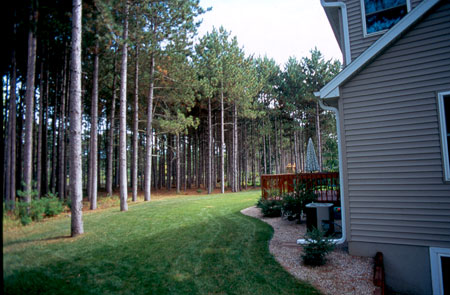There are a number of simple things that any landowner can do to protect their home and property from damage from wildfires.
My wife and I bought a home north of Rhinelander on a pretty dry parcel of land. To say that it is sandy is a bit of an understatement. The description in the soil survey for Oneida County might as well have called it beach sand. Needless to say, the soil has had a big impact on what we grow (or at least try to grow), and how we manage the trees and forest near to and out a ways from our house. The thing with wildfires is that you don’t have to be living in a jack pine stand or a scrub oak forest to be in danger of damage and loss due to wildfires. The principles I apply to our little “dust bowl” are the same ones I advise my wife’s grandfather to implement on his farm and woodlot located on heavy soils that have a great deal of water holding capacity. The year round danger of a wildfire occurring on his farm is less than on our property, but there still is a danger and something all landowners need to consider for their property.
Fire needs fuel to continue to burn and move across a landscape. Therefore, your goals for your property need to be to restrict the movement of any wildfire, ensure that a fire stays small, and prevent fire from reaching any buildings you want to protect. Keep in mind that wildfires, like insect outbreaks, are a natural part of our forest ecology. We can try to reduce their occurrence and contain them, but we will never completely eliminate them.
When we bought our property, we liked that it was a blank slate for our landscaping adventures. The previous owners pursued a park-like appearance for the property, so when we arrived there was a great deal of lawn surrounding the house. I quickly had to reign in my wife’s visions of an abundance of trees and shrubs hugging our house, and get her more in tune with the notion of “lean, clean, and green.” This meant that for the area surrounding the house, a “lean” number of trees and shrubs, “clean” of fallen branches and dead leaves, and “green,” healthy, and actively growing plants and lawn. This didn’t mean that she couldn’t implement her plans to create some cover and food sources for wildlife. It just meant that what she chose to plant needed to be adapted to our soil and climate, and that we needed to keep things healthy. It also meant that we needed to keep enough space between trees so that a fire could not move from one tree to the next.
As we turned our attention to the trees and shrubs growing further out from our house (say about 30 feet out and beyond), we focused on maintaining their health and continued vigorous growth. That meant removing many of the standing or fallen dead trees, and leaving only a few for wildlife habitat. We also thinned out denser groups of trees to make room for the remaining trees to flourish and reduce the concentration of fuel for a wildfire. Neither of these activities were a radical departure from anything we might have wanted to do to achieve our other goals for our property and instead fit well with our overall management.
In a previous article, I talked about trail design and maintenance and I wanted to expand on that a bit more here. Trails provide access to different parts of your property, which is critical if you want to move equipment into a section of your forest that might be ablaze. The ideal situation is to keep trails wide enough, and without sharp turns, for fire fighting equipment. However, narrower trails can at least act as a firebreak, and thereby restrict the movement of fires on your property. For that to happen, trails need to be kept cleared of dense vegetation and excess leaf litter; mowing is a great way to do just that. It is especially important to do a final mowing late in the fall so that there is not a lot of dead vegetation laying on your trail come spring when the fire season kicks off again.
I am happy to report that we have not had a wildfire incident on our property and hope to keep it that way. Part of it is luck and part of it is the steps we take to reduce the possibility of starting a wildfire. However, should a wildfire be burning in our area and headed toward our property, the modifications completed on our property might be enough to keep the fire from reaching our home.
